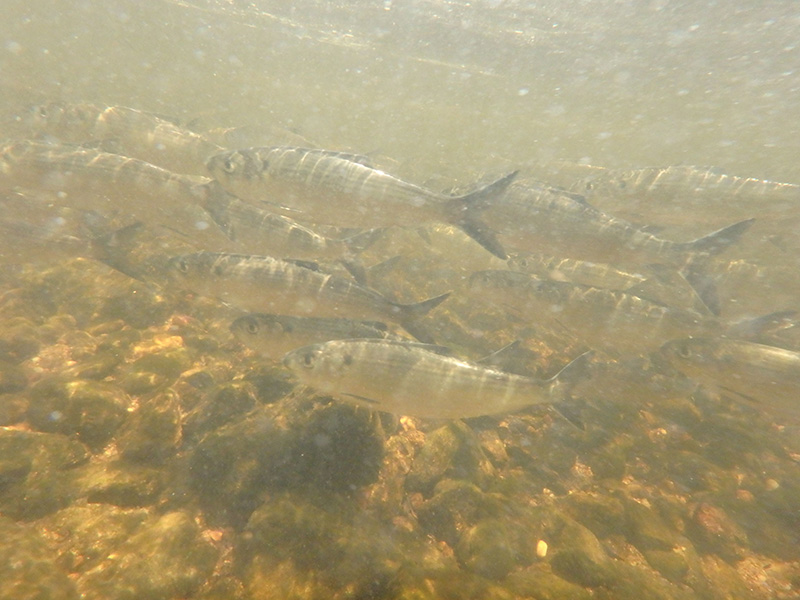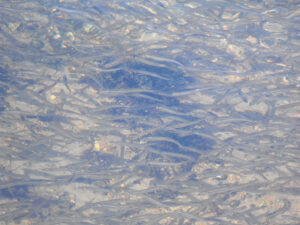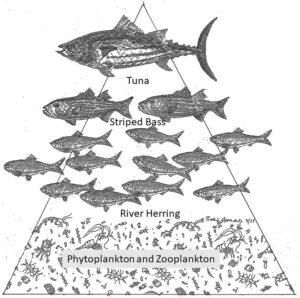
Let’s Not Lose More Fish Species
The Connecticut River ecosystem has a complex food web below the surface. The foundation of this web is made up of all sorts of microscopic planktonic plants and animals. Apex predators, at the top—such as bald eagles and striped bass—can’t eat such miniscule organisms and so depend on a diet of “middlemen” such as river herring—alewife and blueback herring—that consume and convert them to the fish flesh these predators can use. The river herring are important members of a group referred to as “forage fish.” Forage fish are critically important because they feed everything else, like eagles, striped bass, and so much more. River herring are especially important because these two species are anadromous (spawning in freshwater but growing to maturity in saltwater) and therefore critical to food webs not only in the Connecticut River and in Long Island Sound but also in the Atlantic Ocean. Whether consumed by an osprey over Essex or a whale off of Stellwagen Bank, these forage fish sustain apex species wherever they are.

Blueback herring and alewives ascend the Connecticut River and many of its tributaries each spring to spawn. These twelve-inch fish and their small offspring are important food for birds, mammals, and other fish. Image Credit: Sally Harold.
Logic tells us that if we want healthy populations of striped bass and tuna, we need to have healthy populations of forage fish like river herring. Although we often lavish attention on charismatic apex predators, which creates conservation-driven regulations, clubs, marketing campaigns, and foundations that raise money to support their protection, we ignore the less charismatic forage species like river herring, menhaden, sand lance, and anchovies. By ignoring the importance of the forage species, we jeopardize the long-term prosperity of the apex gang.
Just how are these species protected? Fisheries in inland waters like the Connecticut River are managed by the individual states. When the runs of river herring in the Connecticut River dropped precipitously starting in the 1990s, Connecticut and Massachusetts prohibited catching the two species in the river in their state waters. Coastal states regulate coastal waters out to twelve miles, and Connecticut unilaterally closed its coastal waters (basically Long Island Sound) to the taking of river herring in 2002. Ocean waters between 12 and 200 miles are “federal waters,” and fish in this so-called Exclusive Economic Zone are managed jointly by the National Marine Fisheries Service (under the Department of Commerce) and regional fisheries management councils on which sit representatives from each state and the fishing industry that they regulate. The New England Fisheries Management Council (NEFMC) headquartered in Newburyport, Massachusetts, adopts fishery management plans for species off the New England coast and sets regulations, quotas, etc., based upon such plans. It does not have a management plan for river herring. This is an example of not taking the protection of forage species seriously. Regulations are meant to help us avoid the “tragedy of the commons,” whereby individuals, without incentive to conserve a common resource (which fish in state and federal waters are), tend to overharvest, overfish, or mismanage resources. These government agencies and councils have a responsibility to manage fish for the benefit of all people, even those who do not fish.

Historically, river herring were present in our streams in incredible abundance almost daily from April through early July. Thick schools like this are now only seen for a few days each year. Image Credit: Sally Harold.
River herring in the Connecticut River and other southern New England streams are in trouble. Since the early 1990s, their numbers have plummeted. Blueback Herring used to run as far upstream as Bellows Falls, Vermont. We do not know precisely how many bluebacks ran up the river in the early 1600s, but it is likely that they numbered in the double-digit millions. Astounding abundance for all. Their numbers crashed when the three lowermost dams were built on the Connecticut River, but after fishways were built at those dams and pollution was largely abated, the numbers started rising. In 1985, 632,255 bluebacks were lifted over the Holyoke Dam. The numbers declined so drastically thereafter that in 2006, only 21 were counted! Alewives do not go upstream as far as Holyoke so we don’t have numbers for them there, but the counts at fishways on coastal streams (where alewives dominate) have seen similar alarming declines, and bluebacks are now practically absent from coastal streams in Connecticut. This is after forty years of improving water quality, removing unneeded dams, and building fishways—over sixty in Connecticut. These fish numbers should be rising. The situation is the same in Rhode Island, New York, and parts of Massachusetts.
Like most ecological problems in the North Atlantic basin, there may be more than one “smoking gun,” but there’s a lot of smoke coming out of the gun that points to an offshore bycatch problem. Bycatch is what’s caught unintentionally along with the species the netters are targeting. In this case, there is a large trawl fishery for Atlantic herring, a marine species closely related (and resembling) the two river herring species. (If you eat pickled herring or smoked herring, it is Atlantic herring you’re eating.) These days, most of these herring are harvested for lobster bait, and while we no longer have that fishery in Connecticut, the Maine lobster industry is booming. The Atlantic herring fishing fleet (Americans) fishes federal waters off Montauk and Block Island during the winter. Unfortunately, this is where and when our river herring congregate while preparing to run up our rivers to spawn in April and May. Paired trawlers pull a massive net between them and scoop up all of these intermingling fish. Once they’re on the deck, they’re dead. Genetic analyses by labs at Yale, University California-Santa Cruz, and elsewhere have published data to show that the watersheds most negatively impacted by this bycatch are those flowing into Long Island Sound and neighboring shorelines of Rhode Island and Massachusetts. The timing of the escalation of this fishery coincides with the crash in the numbers of blueback herring in the Connecticut River.

A food web can be imagined as a pyramid with the tiniest of organisms at the bottom and the apex predators at the top. The two river herring species play a critical role as forage species that support the highly valued species at the top. Image Credit: Sally Harold.
The NEFMC does not manage river herring, but it has a management plan for Atlantic herring, and it should be managing that species to minimize deleterious impacts to other species, habitat, and the ecosystem. Advocates for river herring have argued that the southern New England Atlantic herring winter fishery is driving our river herring populations to near extinction and have urged a seasonal area closure to allow our fish to return to inland waters to spawn without interference by nets. The NEFMC has been slow to act, at first stating that river herring are not in trouble based on the abundance of the species in Maine. The reason why there are a lot of river herring in Maine is because the agencies closed the inshore area of the Gulf of Maine to herring trawlers. That’s what we want for southern New England! What’s fair is fair! In 2021, the NEFMC implemented the area closure under so-called Amendment 8, but the courts vacated the rule on procedural grounds. NEFMC recently adopted a “problem statement” that will guide its actions to revisit this issue starting at its September 2023 meeting. It is unlikely that final decisions were made then, and we need to keep the pressure on the Council until an effective area closure is in effect.
If you care about Connecticut River’s river herring, consider contacting the NEFMC and telling it what you think. Tell them that the Council should properly manage fisheries for the benefit of all of New England residents, not just some. Tell them that forage fish like river herring are critically important for both inland and coastal ecosystems. Tell them that Connecticut and Connecticut River communities are spending a lot of money tearing out dams, building fishways, improving habitat, and closing freshwater river herring fisheries so that our children can marvel at the sight of their annual migrations and help maintain the strong base of a food web on which so much marine (and terrestrial life) depends. Tell them that important fisheries like Atlantic herring need to be managed so as not to decimate other species, like river herring. We lost the river’s Atlantic salmon many generations ago. The New England cod fishery has collapsed. Let’s not have to tell our grandchildren how we let these other New England icons—the river herring—disappear on our watch.
If you send an email to Estuary magazine at admin@estuarymagazine.com with the comment “please send draft letter to protect river herring,” Estuary will send you a draft letter that you can send to the New England Fisheries Management Council. Every voice (every fish) counts!
